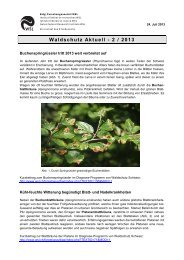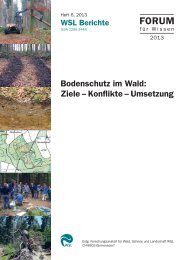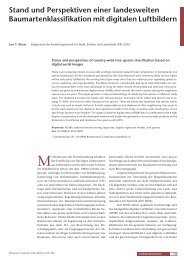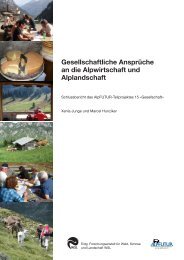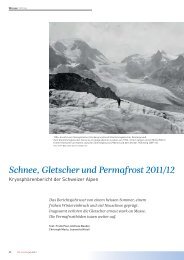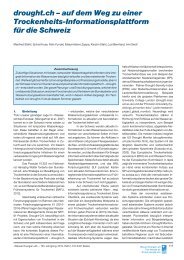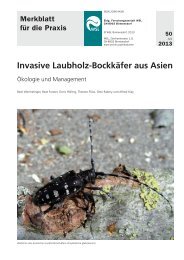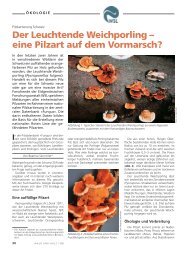Ecology and management of the spruce bark beetle Ips ... - WSL
Ecology and management of the spruce bark beetle Ips ... - WSL
Ecology and management of the spruce bark beetle Ips ... - WSL
Create successful ePaper yourself
Turn your PDF publications into a flip-book with our unique Google optimized e-Paper software.
72<br />
<strong>bark</strong> <strong>beetle</strong> larvae during its development (Heidger,<br />
1994; Hérard <strong>and</strong> Mercadier, 1996; Dippel et al.,<br />
1997). In addition, <strong>the</strong> adult <strong>beetle</strong> devours some<br />
100 I. typographus during its life span (Heidger,<br />
1994). At high densities <strong>of</strong> T. formicarius cannibalism<br />
or emigration may occur (Weslien, 1994). Among <strong>the</strong><br />
most important mortality factors acting on <strong>the</strong> <strong>spruce</strong><br />
<strong>bark</strong> <strong>beetle</strong> larvae seem to be predatory Medetera<br />
flies (Schopf <strong>and</strong> Köhler, 1995; Lawson et al., 1996;<br />
Wermelinger, 2002), although <strong>the</strong>ir larval consumption<br />
is only 5–10 scolytid larvae (e.g. Dippel et al., 1997).<br />
Their low voracity can be compensated for by <strong>the</strong>ir<br />
high abundance.<br />
Relatively high mortality rates <strong>of</strong> <strong>the</strong> European<br />
<strong>spruce</strong> <strong>bark</strong> <strong>beetle</strong> due to natural enemies have been<br />
documented in short term investigations. Eck (1990b)<br />
recorded local parasitism rates <strong>of</strong> up to 30%. In<br />
exclusion experiment <strong>the</strong> <strong>of</strong>fspring production <strong>of</strong><br />
I. typographus in caged logs without predation <strong>and</strong><br />
parasitism was found to be 1.3–5 times higher<br />
than that in uncaged logs (Weslien <strong>and</strong> Schroeder,<br />
1999).<br />
In a biennial study, mortality imposed by predators<br />
<strong>and</strong> parasitoids increased from 558 %to828 % during<br />
two years <strong>of</strong> an ongoing infestation (Wermelinger,<br />
2002). While <strong>the</strong> predators were <strong>the</strong> main cause <strong>of</strong><br />
mortality in <strong>the</strong> first year, higher <strong>bark</strong> <strong>beetle</strong> mortality<br />
was caused by parasitoids in <strong>the</strong> second year <strong>of</strong> <strong>the</strong><br />
study. However, a 3 year study in <strong>the</strong> National Park<br />
Bavarian Forest revealed no consistent pattern in <strong>the</strong><br />
development <strong>of</strong> antagonistic species (Schopf <strong>and</strong> Köh-<br />
B. Wermelinger / Forest <strong>Ecology</strong> <strong>and</strong> Management 202 (2004) 67–82<br />
Fig. 1. Emergence dynamics <strong>of</strong> <strong>bark</strong> <strong>beetle</strong>s <strong>and</strong> associated natural enemies from logs <strong>of</strong> <strong>bark</strong>-<strong>beetle</strong>-infested <strong>spruce</strong> trees: <strong>Ips</strong> typographus<br />
(Scolytidae), Lonchaea spp. (Lonchaeidae), Medetera spp. (Dolichopodidae; both predatory Diptera), <strong>and</strong> Roptrocerus spp. (Pteromalidae,<br />
parasitic Hymenoptera). Methods in Wermelinger (2002).<br />
ler, 1995). Cold temperatures during wintertime seem<br />
to be equally detrimental to parasitoids <strong>and</strong> to <strong>bark</strong><br />
<strong>beetle</strong>s (Faccoli, 2002).<br />
A density-dependent response <strong>of</strong> natural enemies<br />
to <strong>bark</strong> <strong>beetle</strong> outbreaks was documented by Lawson<br />
et al. (1996). On <strong>the</strong> o<strong>the</strong>r h<strong>and</strong>, local <strong>bark</strong> <strong>beetle</strong><br />
populations in existing infestation spots may be<br />
replenished by immigrating I. typographus but not<br />
by, e.g. T. formicarius <strong>beetle</strong>s (Weslien <strong>and</strong> Schroeder,<br />
1999), even though <strong>the</strong>y are also good flyers<br />
(Heidger, 1994). The <strong>spruce</strong> <strong>bark</strong> <strong>beetle</strong> has high<br />
dispersal abilities <strong>and</strong> can thus escape <strong>the</strong> local<br />
mortality agents. At new potential infestation spots<br />
<strong>the</strong> local density <strong>of</strong> antagonists may be still low,<br />
which allows <strong>the</strong> <strong>bark</strong> <strong>beetle</strong>s to build up new<br />
populations successfully.<br />
Antagonists depend on food not only during <strong>the</strong>ir<br />
development, but also as adults. While adult predators,<br />
such as clerid <strong>beetle</strong>s, have food sources similar to<br />
those <strong>of</strong> <strong>the</strong>ir larvae, parasitic wasps depend on energy<br />
sources such as pollen, nectar or honeydew. It has been<br />
shown that, even in <strong>spruce</strong> plantations, several plant<br />
species are able to provide <strong>the</strong>se resources (Hougardy<br />
<strong>and</strong> Grégoire, 2000).<br />
Little research has been carried out in recent years<br />
on <strong>the</strong> impact <strong>of</strong> woodpeckers on I. typographus.<br />
Although <strong>the</strong>y generally prefer larger prey than scolytids<br />
(Nuorteva <strong>and</strong> Saari, 1980), <strong>the</strong> three-toed<br />
woodpecker (Picoides tridactylus [L.]) in particular<br />
is considered an important forager on conifer <strong>and</strong><br />
broadleaf <strong>bark</strong> <strong>beetle</strong>s. In a faeces analysis <strong>of</strong> this



